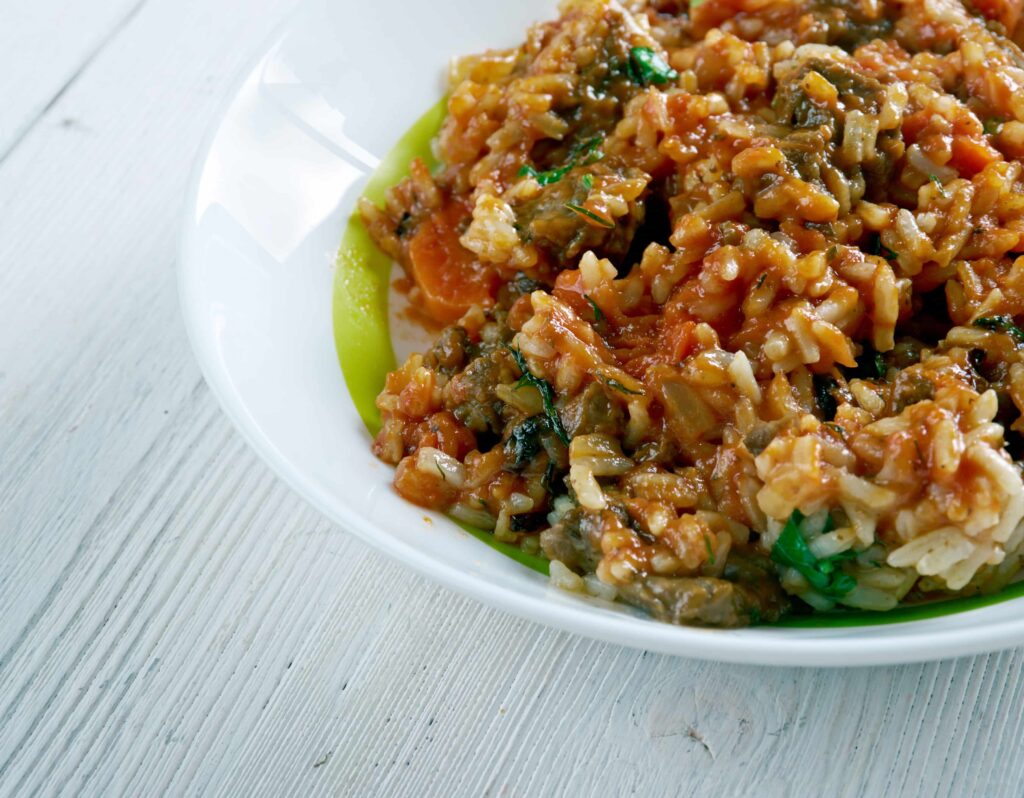
Skoudehkaris is a well-known dish in Djibouti. It’s a flavorful meal that often graces the tables of locals and visitors alike.
Our team at Remitly created this guide as part of our series that celebrates the traditional foods of our global customers. Enjoy!
The Origin of Skoudehkaris
The roots of Skoudehkaris are deeply embedded in Djiboutian culture. This dish has been passed down through generations, each adding their own touch to the recipe. Its origin is not precisely known, but it’s acknowledged as an integral part of Djiboutian cuisine.
Skoudehkaris reflects the country’s history and its interactions with different cultures over time. It’s a testament to Djibouti’s resilience and adaptability, mirroring its people’s ability to create something beautiful out of simplicity.
Ingredients Used in Skoudehkaris
The ingredients used in Skoudehkaris are simple yet full of flavor. Rice forms the base of this dish, providing a canvas for other ingredients to shine.
Tomatoes add color and tanginess while onions lend sweetness and depth. Meat—usually lamb—is also included for protein and richness. Spices like cumin, coriander, cardamom, and cloves infuse the dish with warmth and complexity.
Skoudehkaris Recipe
Ingredients
- 2 cups of rice
- 1 pound of lamb, cut into chunks
- 2 large onions, finely chopped
- 4 ripe tomatoes, diced
- 3 cloves of garlic, minced
- 1 teaspoon of cumin
- 1 teaspoon of coriander
- Half a teaspoon of cardamom
- A pinch of cloves
- Salt and pepper to taste
- Cooking oil
Instructions
- Heat the oil in a large pot over medium heat.
- Add the lamb chunks and brown them on all sides. Remove and set aside.
- In the same pot, add the onions and sauté until they become translucent.
- Add the garlic and cook for another minute.
- Stir in the tomatoes along with cumin, coriander, cardamom, cloves, salt, and pepper.
- Return the lamb to the pot and mix well with other ingredients.
- Add rice to the pot and stir until it’s well coated with spices.
- Cover with water (about four cups) then reduce heat to low.
- Cover the pot and let it simmer for about an hour or until rice is cooked through and has absorbed all flavors.
Remember: patience is key when making Skoudehkaris—the longer it cooks, the better it tastes!
Variations of Skoudehkaris Across Djibouti
Across Djibouti, variations of Skoudehkaris can be found. Some households prefer to use chicken instead of lamb, while others might add vegetables like carrots and peas for extra nutrition.
In coastal areas, fish is often used in place of meat. Regardless of the variation, the essence of Skoudehkaris remains the same—a comforting dish that brings people together.
How Skoudehkaris is Served and Enjoyed
Skoudehkaris is typically served hot, straight from the pot. It’s often enjoyed with a side of fresh salad or yogurt to balance its rich flavors.
Eating Skoudehkaris is a communal affair. Families gather around the dish, sharing stories and laughter as they savor each bite. It’s not just about nourishment—it’s about connection and tradition.
Influence of Other Cultures on Skoudehkaris
The influence of other cultures on Skoudehkaris is evident in its ingredients and preparation methods. The use of spices reflects Indian influences while the one-pot cooking technique echoes Middle Eastern culinary traditions.
Despite these influences, Skoudehkaris retains its unique Djiboutian identity. It’s a beautiful blend of different cultures—a testament to Djibouti’s openness and diversity.
Djiboutian Cuisine: A Melting Pot of Flavors
Djiboutian cuisine is as diverse as its people—a blend of African, Middle Eastern, Indian influences that create a unique culinary landscape.
Staple Foods
Rice is a staple food in Djibouti—often served alongside meat or fish dishes like Skoudehkaris. Flatbreads like lahoh and injera are also common, used to scoop up stews or dips.
Meat and Fish Dishes
Lamb is a favored meat in Djibouti, featured in many dishes including Skoudehkaris. Goat and chicken are also popular. In coastal areas, fish is a mainstay—grilled, fried, or stewed with spices.
Vegetables and Legumes
Vegetables like tomatoes, onions, bell peppers, and zucchini are often used in Djiboutian cuisine. Legumes such as lentils and chickpeas feature prominently too—cooked into hearty stews or served as side dishes.
Spices
Spices play a crucial role in Djiboutian cuisine. Cumin, coriander, cardamom, cloves—the same spices found in Skoudehkaris—are widely used to add depth and complexity to dishes.
Djiboutian cuisine is a testament to the country’s rich cultural heritage—a melting pot of flavors that tells stories of its past while celebrating its present. Whether you’re savoring Skoudehkaris at home or exploring other Djiboutian dishes, you’re partaking in a culinary journey that’s both delicious and enlightening.
Visit the homepage, download our app, or check out our Help Center to get started.